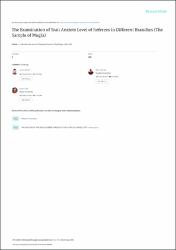| dc.contributor.author | Onturk, Yavuz | |
| dc.contributor.author | Bingöl, Erkan | |
| dc.contributor.author | Efek, Engin | |
| dc.contributor.author | Bayrakdaroglu, Yesim | |
| dc.contributor.author | Gorun, Levent | |
| dc.date.accessioned | 2020-11-20T14:39:25Z | |
| dc.date.available | 2020-11-20T14:39:25Z | |
| dc.date.issued | 2020 | |
| dc.identifier.issn | 2322-3537 | |
| dc.identifier.uri | https://hdl.handle.net/20.500.12809/425 | |
| dc.description | WOS: 000551915700017 | en_US |
| dc.description.abstract | The aim of this study to examine the trait anxiety level of referees in different branches in terms of some variables. For the model of the research, the survey model, one of the quantitative research types, was chosen. While the population of the research is composed of referees working in different branches in Mugla Province, the sample is composed of 167 referees who have been chosen by a randomized sampling method and participated in the research voluntarily. The authors designed a personal information form for the demographical information of the participants. The "Trait Anxiety Inventory" developed by Spielberger, Gorsuch and Luschene (1) (1970) and adapted to Turkish by Oner and Le Compte (2) (1983) was used to determine the participants' anxiety levels. The data obtained from the form and scale used were analyzed using the SPSS 17 package program. Frequency, percentage, average, and standard deviation values were used in the analysis of the data. Data normal distributions were analyzed with Skewness-Kurtosis values. Since the data showed normal distribution, t-test and ANOVA test, which are parametric tests, were used, and the significance level was accepted as p <0.05. According to the findings of the study, while the anxiety levels of the referees showed significant differences in terms of gender, they did not display a significant difference with the variables of age, education level, refereeing time and refereeing classification. Consequently, the trait anxiety levels of female referees are significantly higher in favor of the trait anxiety levels of male referees. This study revealed that anxiety-reducing training should be focused on reducing the trait anxiety situations that female referees experience more than male referees. | en_US |
| dc.item-language.iso | eng | en_US |
| dc.publisher | Int Journal Applied Exercise Physiology | en_US |
| dc.item-rights | info:eu-repo/semantics/openAccess | en_US |
| dc.subject | Referee | en_US |
| dc.subject | Trait Anxiety | en_US |
| dc.subject | Gender Differences | en_US |
| dc.title | The Examination of Trait Anxiety Level of Referees in Different Branches (The Sample of Mugla) | en_US |
| dc.item-type | article | en_US |
| dc.contributor.department | MÜ, Köyceğiz Meslek Yüksekokulu | en_US |
| dc.contributor.institutionauthor | Bingöl, Erkan | |
| dc.identifier.volume | 9 | en_US |
| dc.identifier.issue | 7 | en_US |
| dc.identifier.startpage | 152 | en_US |
| dc.identifier.endpage | 159 | en_US |
| dc.relation.journal | International Journal of Applied Exercise Physiology | en_US |
| dc.relation.publicationcategory | Makale - Uluslararası Hakemli Dergi - Kurum Öğretim Elemanı | en_US |


















